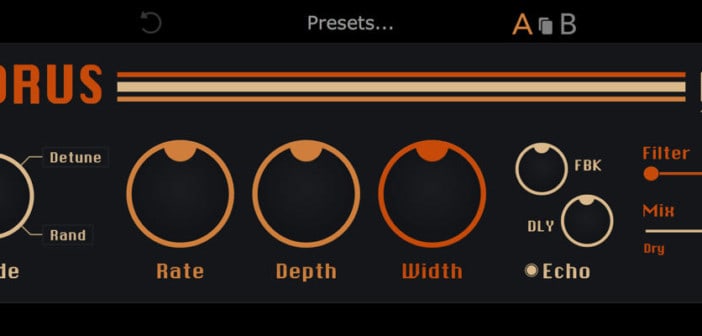VST chorus effect plugins are easy to come by. There are even free chorus effects, several of which are expertly cataloged here on Bedroom Producers Blog. Unfortunately, most of them (with a few notable exceptions) are utterly forgettable and poorly coded. But that’s not at all the case with Echorus by Tritik, which is one of the most charming chorus effects I’ve used in a good long while. In fact, I prefer Echorus to my chorus pedal on my guitar rig.
The Review
As is the case with all of Tritik’s plugins, the fully-resizable UI has a very simple, intuitive look and feel, optimized for retina / high-resolution displays. Several aspects of Echorus are identical to those in Tritik’s other products, such as an Undo button, a Preset Browser with expandable nodes, a “Freezer” with a list of parameters that will not change (if selected) when loading presets, an A/B switch with a button that will copy the active state to the inactive one, plus some helpful Tips in the Preferences menu.
The Mode knob will switch between four original chorus algorithms…
- Retro: A single pair of delay lines and LFOs. Very warm. Very basic. Obviously very “old school”.
- Multi: Four delay lines per channel, each one modulated by its own LFO, resulting in very complex, “swirly” modulations.
- Detune: Not a modulated delay line, but a pitch-shifted copy of the dry signal controlled by the Rate/Depth knobs in a very specific way. The Depth knob will tune the pitch shifter from -30 to 30 cents, whereas the Rate knob adds subtle modulations independent of the Depth value.
- Random: Eight delay lines per channel, each one modulated by its own random walk generator. Ideal for thick, evolving sounds and less “wobbly” and predictable than traditional chorusing using classical waveforms (sine, triangle, etc.) for modulation.
The Width knob will determine the stereo width of the chorused signal; my guess is that delay times are adjusted incrementally to “widen” the signal output, which is something you hardly ever see in common, garden variety chorus effect plugins.
Another added feature is the Echo section, which has a dedicated on/off switch, and Delay and Feedback knobs. I couldn’t help but notice that the echoes are feedback-dependant, which isn’t very noticeable until you turn the Feedback knob below twenty percent. I think it would be nice to have an option to switch this feedback dependency off for echoes without much (or any) feedback. Also, delay times are measured in milliseconds only, which isn’t the end of the world, but tempo-synced delay times would be nice.
Another thing that really helps out is the Filter control with two handles for analog-modeled high-pass and low-pass filters. I usually roll off everything below 200 Hz in order to avoid a muddy sounding chorus, and I also like having the ability to darken things up with the low-pass filter if need be.
The Verdict
Echorus is one of the most analog-sounding digital effects I’ve laid ears on. There are no harsh aliasing artifacts, no weird phase correlation problems or glitchy modulations. Each algorithm has a distinct usefulness and a very pleasant thickness that feels warm and natural. It can also sound very unnatural if you want it to. Suffice it to say that before I used Echorus, I did not have a favorite Chorus plugin…
Now I do.
More info: Tritik Echorus (€49)
More articles:
- Tritik KrushPro Review
- Tritik Releases Free Krush Bitcrusher/Filter VST/AU Plugin
- Download 1GB Of FREE Analog Synth Samples By Sharooz Raoofi
- Free Compressor VST Plugins
Tritik Echorus Review
Echorus is one of the most analog sounding digital effects we’ve laid ears on.
-
Features8
-
Workflow9
-
Performance10
-
Design9
-
Sound10
-
Pricing9



10 Comments
marti garaughty
onNice for the price…
Johannes
onwould really like to hear your opinion on AconDigital’s Multiply. this is my favourite chorus plugin
Tomislav Zlatic
onMultiply is amazing. The best freeware chorus (along with Azurite by Distorque), in my opinion.
sascha
onGreat Bryan! THX but it doesn’t work! Gonna try it later on
bob
onThe giveaway widget wasn’t working for me neither yesterday. seems fixed now (not sure why it should says 34 days left though?)
Tomislav Zlatic
onOops, it was set to the wrong date. Fixed! :)
Perry Staltic
onSounds interesting.
sec0ndskin
onthanks guys for your amazing plugins!!!
Charles / Tritik
onThanks everybody and congrats to Javier!
Hope you guys will enjoy using Echorus as much as we enjoyed making it!
Tomislav Zlatic
onThanks for the giveaway! :)